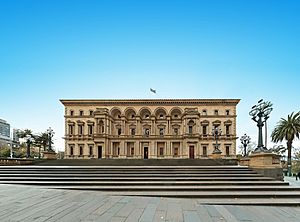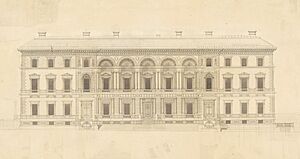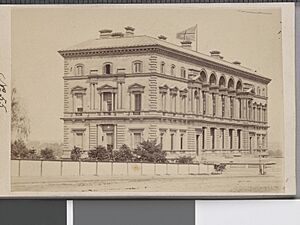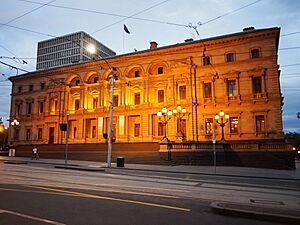Old Treasury Building, Melbourne facts for kids
The Old Treasury Building is a grand old building located on Spring Street in Melbourne, Australia. It was built a long time ago, between 1858 and 1862. It was designed to look like buildings from the Renaissance Revival period, which means it has a fancy, classic style.
Originally, this building was meant to hold the government's money department (the Treasury Department) and offices for important government leaders. It even had special vaults in the basement to store gold from the Victorian gold rush! Today, the Old Treasury Building is home to a museum that tells the story of Melbourne's history. It's called the Old Treasury Building Museum.
Quick facts for kids Old Treasury Building |
|
|---|---|

Old Treasury Building
|
|
| General information | |
| Status | Complete |
| Type | Public |
| Architectural style | Renaissance Revival |
| Location | Victoria |
| Address | 20 Spring Street, East Melbourne |
| Country | Australia |
| Coordinates | 37°48′47″S 144°58′27″E / 37.813153°S 144.974121°E |
| Construction started | 1858 |
| Completed | 1862 |
| Owner | Victoria State Government |
| Design and construction | |
| Architect | John James Clark |
| Official name | Old Treasury Building |
| Type | Historic |
| Designated | March 21, 1978 |
| Reference no. | 5210 |
| Official name | Treasury Reserve Precinct |
| Type | State Registered Place |
| Designated | 20 August 1982 |
| Reference no. | H1526 |
| Heritage Overlay number | HO174 |
Contents
History of the Old Treasury Building
The Old Treasury Building was built between 1858 and 1862. It is known as one of Australia's most beautiful Renaissance Revival style buildings.
Gold Vaults and Government Offices
One of the first ideas for the building was to store gold from the Victorian gold rush in its basement vaults. However, by the time the building was finished, the gold rush was mostly over. So, instead of gold, the vaults were used to store important government papers.
The main reason for the building was to provide offices for the Treasury Department. It also had rooms for other key government officials. These included the Chief Secretary, the Treasurer, and the Governor of Victoria. The Governor used a room here when dealing with government business.
Designed by a Young Architect
A very young architect named J. J. Clark designed this impressive building. He was only 19 years old when he started the design in 1857! He even took a break to travel in Europe and the United Kingdom while the first parts of the building were being constructed.
When he returned, he finished the design. Many of his original drawings are still shown in the building today. An expert on buildings, Miles Lewis, once said the Old Treasury was the "finest public building exterior in Australia." Clark designed many other important government buildings later on.
Completing the Forecourt
Even though the building itself was finished in 1862, the grand entrance area, called the forecourt, took longer to complete. For a while, there were just wooden stairs leading to the doors. In 1868, these were replaced with the beautiful forecourt and cast-iron lamps that you can still see today. J. J. Clark also designed these.
The Old Treasury Building is a very important part of the government area in Melbourne. It sits next to the Treasury Gardens and creates a stunning view at the end of Collins Street.
The "Old Treasury" Nickname
In 1877-78, the main treasury offices moved to a new building next door. That's when this building got its nickname, the 'Old Treasury'.
A Place for Public Events
Because of its important location and open space around it, the Old Treasury Building has been a central spot for many celebrations and big public events. For example, when Governors of Victoria arrived or left, people would gather here. In recent years, it has been the finishing point for the Grand Final parade for Australian Rules Football players.
Australia's Temporary Capital
The building also played a special role when Melbourne was the temporary capital city of Australia. This happened after Australia became a federation of states. In 1899, a special meeting was held here where leaders decided that Melbourne's Parliament House would be the temporary capital. This was until the official location for the Australian National Capital was chosen.
The Old Treasury Building Museum
In the 1970s, the government started thinking about creating more museums in Victoria. In 1981, a committee was set up to plan for new museums. It was suggested that a new Museum of Social and Political History should be created at the Old Treasury Building.
Finally, after the building was restored, the Old Treasury Building Museum opened in 1994. It has exhibits that show the history of Melbourne, the Victorian gold rush, and the history of the building itself. The museum has changed its name a few times over the years. Since 2011, it has worked with the Public Record Office Victoria to offer programs.
Occupants of the Building
The Old Treasury Building was built to hold the Treasury Department and store gold. But it also provided offices for the leaders of the young colony. These included the Governor, the Premier (who was called the Chief Secretary back then), and the Treasurer.
Even today, the Governor of Victoria still holds weekly meetings of the Executive Council here. This meeting includes the Governor and at least two government ministers. This meeting, called the Governor in Council, is where new legislation (laws) are formally approved. The Governor signs the new laws, and the Great Seal of Victoria is added. Other important appointments and rules are also made at this weekly meeting.
Besides the museum, the Old Treasury Building is now home to the Office of the Victorian Government Architect and The Victorian Marriage Registry. It also has offices for most of the former Premiers of Victoria who are still living.
See also
- Architecture of Melbourne
- List of heritage-listed buildings in Melbourne
- Victorian architecture




